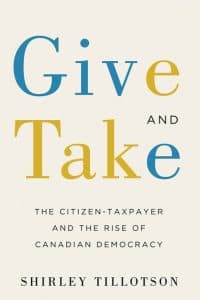
Book Review
Give and Take: The Citizen Taxpayer and the Rise of Canadian Democracy, 2017
By Shirley Tillotson
Buy the book: https://www.ubcpress.ca/give-and-take
When the terms “Taxpayer” and “Democracy” appear in the title (or subtitle) of a book, the reader might expect a disquisition on income inequality, in the wake of Thomas Piketty’s Capital in the 21st Century (which devotes slightly more than two pages to Canada). Shirley Tillotson’s Give and Take does touch on this subject from time to time, but her focus is on the relationship between taxation and democracy as a process, involving the expansion of the incidence of taxes (in this case the federal income tax) and its effects on ideas about government and citizenship.
The income tax in Canada was introduced as a wartime measure in 1917, and it was coupled with an effort to arouse public participation in the Victory Loan bond drive. The tax reached beyond the most wealthy Canadians, in part to promote bond sales by promising future tax relief as well as a good interest rate – the government subsequently reneged at least in part on the tax relief component, but the income tax was here to stay. In the interwar years the government was able to draw upon a residual public association of taxes with property ownership and the role of the citizen with a “stake in society” although the period was not without periodic tax revolts, particularly during the Depression.
During World War II the income tax was extended to wage earners, and featured tax withholding from paycheques, accompanied by government bond drives and a major public relations effort to present taxpaying as a duty of all citizens in defence of the country. As the war ended, emphasis moved to the need to pay taxes to support social programs, beginning with family allowances and old age pensions.
In the postwar period the public attitudes toward taxes shifted from being a duty of citizenship to a burden to be accepted but minimized; curiously, the government contributed to this change by urging people to engage in “tax planning” to avoid “overpayment” and enjoy the benefits of tax refunds. The narrative culminates with the tax reform efforts of the Carter Commission and the Benson White Paper in the late 1960s-70s which featured the introduction of capital gains taxes and raising exemption levels to provide relief to lower income earners, although neither supporters nor opponents seem to have been satisfied with the outcome.
This description of the main theme of the book does not do justice to the breadth and depth of detail that Prof. Tillotson brings to this story, tracing the patchwork evolution of taxes at all levels of government in 20th century Canada, exploring the interconnections of taxes and public finance in wartime, the surreptitious entry of sales taxes (identified as “manufacturing taxes” until the 1990s) into the mix, and drawing on a rich mine of research materials in the tax records that indicate the variety of views that taxpayers brought to the subject in their correspondence with tax collectors and policy makers.
One subtheme that emerges in the book covers the growth of influence of social scientists, particularly economists, from the time of the Rowell-Sirois report, so that by the 1960s tax policies were being shaped to fit macroeconomic goals. At the same time the dramatic expansion of a tax-paying public was accompanied by efforts by the tax collectors to communicate their aims and intentions: during World War II bureaucrats from the Finance Minister J.L. Ilsley down, sought to respond in detail to tax payers venting their complaints or just explaining their beleaguered circumstances. When both the Carter Commission and Finance Minister Edgar Benson, perhaps influenced by the 1960s rhetoric about “participatory democracy” invited responses to their proposals, they experienced a deluge of correspondence, much of it critical.
Some accounts of the fate of tax reform in this era portray it as an earnest effort hijacked by big business interests which attenuated proposals for taxes on capital gains. Prof. Tillotson presents a more nuanced view. Among the most vigorous critics of the reformers were small business proprietors and independent professionals who lamented the influence of “elites” that included bankers, big corporations, and social scientists as well as government bureaucrats – reflecting a “populist” perception familiar to readers today observing the U.S. experience, but which, as Tillotson notes, also has deep roots in Canadian history.
One area which she does not explore in as much detail is corporate taxation, which was introduced even before the income tax, and would provide an interesting counterpoint to her emphasis on individual taxpayers. Issues such as depreciation and depletion allowances, taxation of foreign-owned companies which could use internal transfer prices and dividend policies to affect their tax liabilities, the perennial complaints of “double taxation” imposed on investors as well as corporations --- all these and other features offer research opportunities for historians of business enterprise in Canada.
Graham Taylor
Trent University